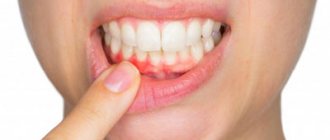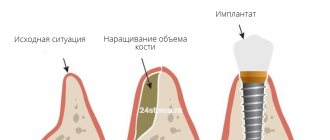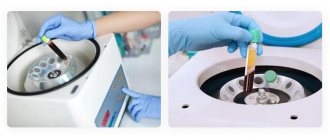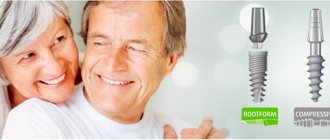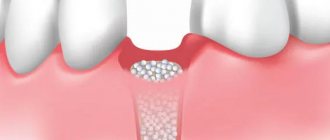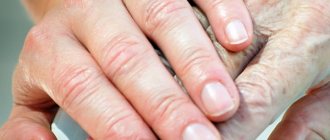679
In dental implantation and bone grafting, guided bone regeneration (GBR) is used to compensate for bone deficiency.
The main problems of NCR are migration of soft tissues into the defect area, infection of the wound by microorganisms, and low rate of osteoregeneration.
Barrier membranes best cope with these problems.
General presentation and purpose
Barrier membranes are single- or multilayer films made from artificial or natural, resorbable or non-resorbable materials.
Main functions of barrier membranes:
- stabilize the blood clot;
- exclude the formation of connective tissue in the area of the bone defect;
- prevent the penetration of microorganisms into the area of osteoregeneration;
- increase the speed and quality of osseointegration processes.
The Bio Gide membrane, produced by Geistlich Biomaterials (Switzerland), is a two-layer resorbable film made from non-cross-linked porcine collagen.
The material is recommended for use in various cases of bone tissue grafting. They cover a wound filled with crushed bone prepared from autogenous material or cattle bones.
Thanks to its unique composition and design, the material promotes accelerated and high-quality regeneration of the jaw bone and a rapid healing process of soft tissues.
Methods of implanting several teeth in a row and the designs used.
Visit here to find out what requirements apply to posterior dental implant systems.
At this address https://www.vash-dentist.ru/implantatsiya/metodiki/provokatoryi-razvitiya-gaymorita-posle.html read why sinusitis occurs after sinus lifting.
Bone grafting is a solution to the problem of atrophy
For quite a long time, bone grafting has been recognized as the most effective method of restoring the width and height of the alveolar process. The technique is constantly modified and becomes safer and less traumatic. In addition, dentists are trying to achieve conditions under which simultaneous implantation will be possible.
There are several basic bone grafting techniques:
- Sinus lift. Restoration of bone volume in the upper jaw in the area of the projection of the bottom of the maxillary sinus. The operation is performed more often than others, since it is here that bone resorption is predominantly observed. The essence of the surgical intervention is that the dentist, in one of the ways (closed or open), gains access to the mucous membrane of the maxillary sinus. He disconnects part of the membrane from the periosteum, and fills the resulting cavity with prepared material of natural or synthetic origin.
- Splitting of the alveolar ridge. An effective technique for correcting the width of any jaw. First, the alveolar ridge is cut and spread apart, after which the graft is placed inside. The advantage of the technique is that the structure is immersed in the spongy tissue of the jaw, where regeneration and replenishment of the bone block is actively taking place. That is why the use of expensive osteoplastic materials is not required here.
- Guided tissue regeneration. This type of bone grafting includes two components: a graft and a collagen membrane. These two components, interacting with each other, help restore the deficit of both the width and height of the alveolar process in any part of the jaws. The technique is rarely used with simultaneous implantation.
- Bone block grafting. This technique involves the use of a natural, preferably autogenous, graft, which is placed on the area where implantation is planned and where the bone tissue has atrophied. The disadvantage of this technique is that the graft is connected to an area of the bone where there are no blood vessels. Engraftment in such conditions occurs slowly.
Patients tend to be afraid of bone grafting, since it is a full-fledged surgical intervention on the teeth. However, all manipulations are carried out under local or general anesthesia, so they do not cause any discomfort. The risk of complications with this manipulation is minimal, and the benefits are undeniable. Even if the atrophy of the alveolar process does not allow immediate implantation, and patients have to wait six months for the implants to take root, it is still better to give preference to bone grafting rather than alternative methods of tooth restoration. Moreover, in modern conditions there are many designs that increase the benefit and effectiveness of bone grafting, for example, fixation of a barrier membrane.
Characteristics
The membrane has two layers. A dense and smooth surface directed towards the soft tissues reduces water absorption and prevents cell migration into the defect fragment.
The porous three-dimensional layer facing the defect acts as a scaffold for the attachment of osteoblastic cells. Its fibrous, hydrophilic structure promotes rapid vascularization (sprouting of blood vessels), the formation of new bone cells, and accelerated wound healing.
The duration of the protective function provided by the Bio Gide membrane is sufficient for the formation of new bone.
During the manufacturing process, the material undergoes multi-stage cleaning, is sterilized using gamma radiation, and is packaged in double packaging. This completely eliminates infection of the wound by pathogenic bacteria and infections that pigs - collagen suppliers - can suffer from.
When using a Bio-Gide membrane, it is recommended to cover it with a mucous flap followed by suturing the latter. However, open wound healing, without covering with a flap, is also possible. Fixation of the film is possible using both suture material and pins.
The porcine collagen from which the membrane is made does not contain cross-linking additives, which facilitates its complete resorption. By 30-40 days, after performing its protective functions, Bio Gide is broken down by enzymes into amino acid formations, which completely, without inflammation, dissolve in the surrounding tissues.
In the supplied kits, the membrane is presented in 3 sizes: 13x25 mm, 25x25 mm, 40x50 mm.
Types of biomaterials used
The method of directed tissue regeneration in surgical dentistry is based on the use of two main groups of membranes: resorbable (collagen, vicryl, polylactic acid, etc.) and non-resorbable (Gore-tex or titanium mesh, with titanium reinforcement, Teflon and others).
Resorbable
Installation of absorbable membranes prevents their removal after the osteoplastic material has engrafted. Such linings do not always remain stable over a long period. To enhance the prolonged action, their composition is supplemented with slowly resorbing substances. One of the main advantages of membrane linings is the possibility of enriching their structure with drugs that enhance osteogenesis, anti-inflammatory, antimicrobial agents, etc.
Types of resorbable membranes:
- Synthetic polymers (polyactides, polyglycolides) and their chemical modifications (for example, Guidor, EpiGuide, Vicryl) - decomposition into microscopic fragments that undergo phagocytosis occurs under the influence of hydrolysis. Among the disadvantages of the products, weak tissue integration and a high likelihood of developing swelling during resorption due to changes in pH in the tissues are noted. Advantages of polymer plates:
- no risk of transmitting an infectious disease;
- hypoallergenic;
- long-term effect (5-6 months).
Non-resorbable
They contribute to the effective restoration of bone in a given volume and trajectory, there are:
- Frameless - for restoration of bone tissue less than 4 mm.
- With a titanium frame - for bone restoration in large volumes, in all directions.
Main advantages:
- high mechanical strength;
- pronounced barrier properties.
These types of pads should be removed after 6-9 months . Consisting of titanium, they are effective in situations where there is a large load on the bone and it is necessary to protect implants or osteoplastic material. The most common indication for use is vertical ridge augmentation. They are removed after restoration of soft and bone tissues damaged during the operation.
Main disadvantages:
- risk of exposure - during suturing of the flap, the insert must be completely closed;
- absence of the process of periosteum formation under the overlay;
- the patient needs to visit the dentist frequently (every 2 weeks).
Statistics show that the most effective membranes are polytetrafluoroethylene (PTFE) GoreTex and aliphatic polyetherurethane (Bone-up). Less commonly used are mesh forms made of calcium sulfate (Capset) or titanium (Frios, BoneShield, Tiomesh).
Advantages
The dental product has multiple positive effects on bone grafting behavior:
- Prevents the migration of soft tissue into the defect area , leading to the unwanted formation of connective tissue and cartilage cells in the new bone.
- Provides rapid healing of the surgical wound , thanks to the three-dimensional structure of the membrane. The internal porous surface of the material creates optimal conditions for the growth of bone cells and blood vessels into the fibrous structure of the inner layer.
- Bio Gide has weak antigenicity , does not cause allergies or rejection, and provides excellent biocompatibility due to the preservation of the native structure of porcine collagen.
- The Bio-Gide membrane is technologically advanced. It is easy to handle and place in the wound. Due to its hydrophilicity, it adheres well to human tissues and osteomaterial, is resistant to stretching, adapts well to the shape of the defect, and maintains structural integrity even when moistened.
- The material can be used without suturing the wound (although suturing is recommended). Dehiscence of the wound edges does not interfere with healing.
- There is no need to remove Bio-Gide (repeated surgery) due to its resorbability.
- The use of Bio-Gide ensures rapid bone and tissue regeneration. According to research, the survival rate of implants using a membrane is 9.3% higher than without it.
Bioresorbable collagen membrane for tissue regeneration
Geistlich Bio-Gide® Shape is a resorbable two-layer barrier membrane made of porcine collagen types I and III of high purity, without cross-linking, for working with the socket of an extracted tooth with a wall defect.
Difference from standard Geistlich Bio-Gide® membrane
- New shape created specifically for holes with defective walls
- smoother surface
- denser structure
Advantages:
- Bio-Hide Shape provides a barrier function, preventing soft tissue ingrowth, thanks to its two-layer structure
- Good healing thanks to three-dimensional fiber structure
- Good adhesion to the bone when wet is ensured by the high hydrophilicity of the fibers
- The dense two-layer structure makes healing possible even when the edges of the surgical wound diverge
- Good tissue integration and improved bone regeneration compared to regeneration with osteoplastic materials alone
- Simplified surgical step without the need to remove the membrane
- Proven effectiveness: using Geistlich Bio-Oss® and Geistlich Bio-Gide produces 11% more new bone tissue than using Geistlich Bio-Oss® alone
Must be moistened before use
Indications and restrictions
The Bio-Gide membrane can serve as a barrier protection for almost all types of bone grafting of the face and oral cavity. In particular:
- for facial plastic surgery to correct bone tissue defects;
- augmentation of the area around the implants , if the latter are installed in fresh extraction holes;
- in the treatment of the jawbone (filling cavities) left after implant rejection, cystectomy or root resection;
- when reforming the alveolar processes in areas of thinning.
The membrane can be used in combination with both autogenous bone and bone substitutes made from animal bones.
Contraindications
- The presence of an acute infection in the oral cavity (infected wounds).
- The patient is allergic to collagen.
- Pregnancy and lactation. There are no data on the negative consequences of using the membrane during pregnancy/lactation, but to avoid unexpected harm to the mother and child, the use of Bio-Gid is not recommended.
Use with caution in the following pathologies:
- chronic infections in the surgical area (osteomyelitis, etc.);
- decompensated metabolic pathologies (osteomalacia, diabetes mellitus, thyroid dysfunction).
- long-term treatment with corticosteroids;
- radiation therapy;
- autoimmune diseases;
- heavy smoking.
The doctor's qualifications when using membranes must be high.
How long does a tooth hurt after implantation, and what can be done?
In this article, we will tell you how to avoid nerve damage during dental implantation.
Here https://www.vash-dentist.ru/implantatsiya/metodiki/s-nemedlennoy-nagruzkoy.html we will discuss the pros and cons of implantation with immediate loading.
What are barrier membranes?
The barrier membrane is one of the most modern and successful inventions in dental practice. Such designs are actively used in almost all surgical interventions. Barrier membranes for bone grafting during implantation can prevent atrophic phenomena in the alveolar process and contribute to the immediate successful fixation of artificial roots. The membrane affects the regenerative abilities of the bone, increasing them, does not allow osteoclasts that are dangerous to bone cells to enter, and minimizes the risk of penetration of pathogenic agents. Thanks to the barrier membrane, graft engraftment is accelerated, as is the overall treatment of the patient.
The membrane for bone grafting is a very thin and fairly elastic plate that is attached to the bone with titanium pins. In this way, the gums are separated from the bone material during the formation of natural jaw tissue.
Types of membranes
There are two types of barrier membranes that are widely used in dentistry:
- Resorbable. This structure gradually dissolves. It does not require separate removal, that is, additional surgical intervention, which means it causes less trauma.
- Non-resorbable. Membranes of this type do not dissolve on their own, which is why patients need an additional stage of treatment - removal of the structure. In most cases they are made of titanium. Such membranes are attached in the presence of a serious deficiency of bone tissue, filled with granules of osteogenic material. Once the alveolar bone and soft gum tissue have recovered, the barrier membrane is removed.
The dentist independently selects the optimal membrane for a specific clinical case. He must take into account that resorbable structures do not fix the grafts well enough, so they are used only for minor atrophies.
Side effects
Bio-Gide film is biocompatible with human body tissue. Allergies are possible only in rare cases with individual intolerance.
Possible temporary reactions that occur during any surgical intervention:
- swelling in the area of the surgical wound;
- local inflammation;
- pain.
Sometimes, rarely, tissue flap rejection, bleeding, and infection are possible. The necessary actions in specific cases are determined by the doctor depending on the clinical situation.
If necessary, the surgical wound is exposed and subjected to curettage and other routine surgical procedures.
Postoperative period
If the membrane is exposed, it usually closes on its own within a few weeks. Membrane removal is usually NOT indicated. However, to minimize bacterial contamination, rinsing with bactericidal solutions is recommended.
If it is necessary to remove the membrane prematurely, it is necessary to numb the adjacent tissues using a local anesthetic. The incision should be made in the tissue area adjacent to the membrane. After carefully folding back the flap, the remaining membrane is removed and the area is curetted to remove inflamed or infected tissue.
To ensure bone regeneration under the membrane, re-intervention in this area should not be carried out earlier than 4-6 months after installation of the membrane.
Application Guide
The oral cavity must be clean before surgery. The patient receives recommendations on dental and oral care. If necessary, professional cleaning is carried out.
The use of the membrane must be carried out in compliance with the principles of sterility applicable to any surgical intervention.
The material is used in the following sequence:
- The defect is filled with autogenous bone or a bone substitute (Bio-Oss or others).
- The membrane is removed from the packaging and cut with scissors to the desired size. For convenience, templates made of aluminum foil or other suitable sterile material may be used.
The Bio-Gide kit contains templates for the most commonly used periodontal forms. The dimensions of the defect must be covered by the membrane by at least 2 mm. This is necessary to prevent connective tissue growth into the newly formed bone. - The product is placed in the wound over the defect. The dense surface marked with the “UP” sign should be located outside the wound area, and the rough surface should be located towards the defect.
Moderate pressure is used to secure the membrane. The pressure time is individual, depending on the speed of impregnation of the membrane. For good adhesion to the wound, the material must be well saturated with blood and exudate. Surgical threads or pins can be used to fix it. - If there is a flap, it is carefully, without tension, sutured with a single thread.
- It is desirable that the wound closes completely. This will prevent the exposed portion from being absorbed too quickly.
However, if the wound cannot be completely closed, this is not an obstacle to the healing process. Clinical practice shows that in most cases, with an open membrane, the healing process proceeds normally. - Postoperative care should ensure the absence of complications. This is achieved by strictly following the recommendations given by the doctor. The most important of them is strict adherence to PR hygiene and the prevention of bacterial infections.
How membranes take root during dental implantation
Collagen membrane overlays reduce the risk of complications due to loss of soft tissue. Non-stitched - due to the healing of soft tissues by secondary intention, the wounds are protected from the general inflammatory process. Both types integrate well into the jaw tissue. The bone under the surface of the barrier plate is regenerated in a manner similar to fetal bone growth.
When using absorbable overlays, the postoperative wound heals without the use of additional medications. Often the healing process of non-resorbable membranes is accompanied by complications, in particular, exposure of the structure. This can lead to infection and inflammation, which means it will have to be removed prematurely.
Often, under the barriers a favorable background is created for the development of microbes, so it is not always possible to achieve the desired result.
Precautionary measures
To prevent the formation of connective tissue epithelium in the wound, the membrane must adhere tightly to the tooth or implant. If necessary, suture material should be used.
Other recommendations:
- Use opened material only once. Unused membrane must be disposed of and its reuse is prohibited.
- Do not use membrane that has expired.
- Store the material at a temperature of 15-25 °C in a dry place.
The video provides an overview of the material's properties.
Reviews
Barrier membranes are always used in combination with autogenous or bone replacement drugs. Therefore, the outcome of the operation depends not only on its quality, but also on the characteristics of the bone materials.
If you have undergone augmentation using a Geistlich membrane or another manufacturer, please share your experience with us by leaving a comment at the bottom of the page.
If you find an error, please select a piece of text and press Ctrl+Enter.
Tags implantation bone materials
Did you like the article? stay tuned
Previous article
Detailed and accessible information about how and when braces are removed
Next article
Review of biocompatible and aesthetic zirconium implants

